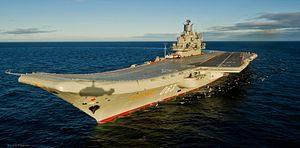The modernization and refitting of the flagship of the Russian Navy, the aircraft carrier Admiral Kuznetsov, is reportedly affected by severe cuts to the Russian defense budget, which is reducing the scope of work for the refit, according to Russian media reports.
An anonymous source told Interfax that the budget will likely be reduced by fifty percent from the proposed $800 million. “Instead of previously planned approximately 50 billion rubles for the work, it is planned to allocate about half of the previously announced amount,” the source said.
The budget cuts will primary affect the modernization of the carrier, whereas repairs “will be carried out in full,” according to the source. The remaining funds will be used to upgrade the carrier’s propulsion systems including replacing four out of the Admiral Kuznetsov’s eight turbo-pressurized boilers while overhauling the remaining four.
While not mentioned by the source, it is likely that the the aircraft carrier’s flight deck also undergo an upgrade of some sorts perhaps including replacement of the deck covering, tail hooks, aircraft arresting gear, and other aspects of the take-off system. What will likely be scrapped are upgrades to the carrier’s electronic warfare, communication, intelligence, navigation, and combat control systems.
Besides budgetary issues, I already expressed my doubts about the feasibility of the ambitious upgrade program back in 2016:
It remains to be seen whether aircraft carrier’s modernization will occur within the announced timeframe. All Soviet carriers were constructed in Ukraine and Russia has lost valuable expertise and technology — particularly surface ship propulsion technology — due to the ongoing crisis in Ukraine. Russia, however, has recently overhauled and modernized a Kiev-class carrier-cruiser for the Indian Navy and gained valuable insights into carrier building techniques through that process. This expertise will prove helpful in overhauling the Admiral Kuznetsov.
No contract between the Russian government and the Zvezdochka shipyard, located in Severodvinsk in Northern Russia, has been concluded. The modernization of the carrier was estimated to take two to three years. However, it is likely that the carrier will be sidelined for longer.
The Admiral Kuznetsov was commissioned in 1990 and has not undergone any major overhauls except for a two-year refit between 1996 and 1998. The Russian Navy’s 55,000-ton flagship has never been deployed for longer than six months and has famously been followed by an oceangoing tug boat during all of its sea voyages due to the carrier’s poor reliability. The ship spent most of its service life in port. As I reported in March:
In October 2016, the Admiral Kuznetsov deployed for three months to the Mediterranean Sea, accompanied by seven other vessels, to support Russian combat operations in Syria. While deployed, the carrier lost two aircraft — a Sukhoi Su-33 air superiority fighter and a MiG-29K/KUB multirole fighter. The Su-33 fighter jet crashed into the sea following a botched landing attempt, whereas the MiG-29 crashed into the sea after the aircraft had run out of fuel.
The air wing of the Admiral Kuznetsov consists of approximately 41 aircraft, including Su-33 air superiority fighters, MiG-29K/KUB fighter aircraft, and Kamov Ka-27, Ka-31, and Ka-52K helicopters. The ship’s 19 Su-33 aircraft are expected to be slowly phased out in the years ahead and will be replaced by the MiG-29K/KUB fighter jets, of which up to 20 can be stationed aboard the Admiral Kuznetsov.
The proposed modernization and refitting is expected to extend the Kuznetsov’s service life by 25 years.

































